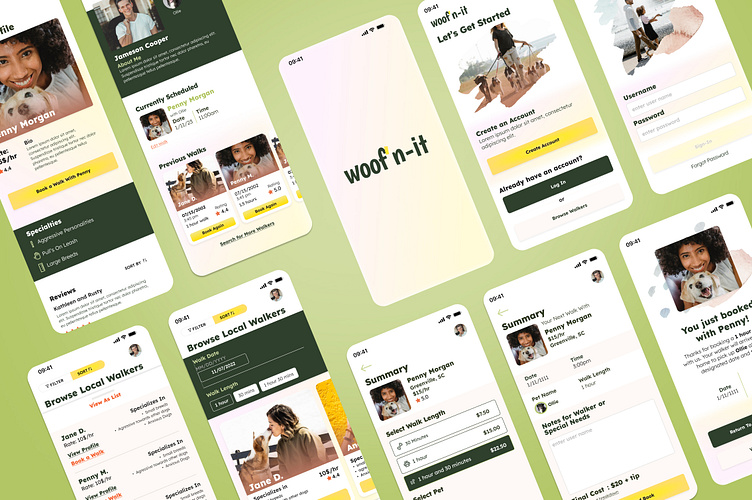Case Study: Woof'n it, a dog walking app
In a post pandemic world where many who became pet owners the last few years are returning to busy schedules, there is a need for services to help care for these new pets. The goal of this project was to solve that problem by researching and designing a concept for a mobile app that would connect dog owners to professional walkers in a convenient streamlined way.
The Key Problems
Making the process streamlined and easy to use, much like other familiar services such as Uber or Airbnb
Building trust from dog owners, so they feel safe entrusting their pets to the walkers
Standing out from other similar applications as the best in market
User Research
For initial user research a few households of dog owners were interviewed about their dog care habits and walks, their interest in a dog walking application, and what concerns they would have in such a service. Two married households in suburban single family homes and one single individual household who live in apartments were interviewed.
Key Findings
Those I interviewed didn't typically walk their dogs. Their dogs are exercised through play in their yards or at a dog park which have to be accessed by car.
The most common pet care services used were kennels/doggy day care for overnight travel, and grooming.
When extra care is needed, friends or family were always the preferred option due to cost and trustworthiness.
Takeaways and Pain Points
Owners are reluctant to spend money on a service when friends and family are available to help care for their pets. A key demographic would be busy individuals without a large support network where they live.
Owners have difficulty trusting strangers with their pets. Especially ones with high needs.
In rural and suburban areas where owners have yards and land the value proposition of a paid walk is a much tougher sell. Our best audience will be in more urban environments.
User Persona
Using this research, a persona of the most likely possible user was created to center the thinking around features and design
Market Research
User Flow Diagrams
User flows were developed for two key tasks in the app, logging in and booking a walk. After exploring competitors, one key difference I wanted to include was the ability to quickly browse the app and available walkers without having to make an account. I also wanted to the make the booking process itself as streamlined as possible by including the input of most general information in the onboarding process.
To help meet LeAnn's needs the flows were intended to be simple and uncomplicated to not cause any stress or friction in the process. Areas for input regarding the special needs of each dog were included to reduce the amount of anxiety an owner may have about their pet. The key screens of the flow were then turned into low and then high fidelity wireframes.
Wire Frames
Visual Exploration and Final Design
First I explored the design systems of similar products that would be familiar to many users and tried to adapt patterns of those into my mockups.
My final choice of colors were meant to evoke those found in nature while still being bright and energetic. The goal was to convey the fun and energy you'd want to have for your dog on a walk but also have elements that would evoke a grounded calming natural environment. Painterly watercolor imagery was used as unique styling and elements as it also creates a similar feeling.
Prototyping and User Testing
An interactive prototype of the two flow scenarios were created in Figma, and tested with three different users given the basic tasks of logging in as an existing user, searching from the list of available walkers, and booking a walk. This testing resulted in a few changes to the design based on user feedback.
Prototype Flow for Finding and Booking a Walk
Observations from User Testing
After conducting a few user test. I organized my results and comments from testers to determine some improvements and refinements of the design and flow.
Changes From Testing and Feedback
Final Thoughts
Through the process of creating this concept, I learned some of the nuances of design for mobile and how to take established design patterns and make them unique to a product and user needs. In the process I feel I was able to create a fresh looking design on a familiar gig service concept.
The value of robust research and testing as part of the design process was also made apparent, even in the small amount of work done here. Should this concept be developed further, expanding that research to include a larger sample diverse households and home demographics would be my first step to ensure the profitability and viability of this concept.












